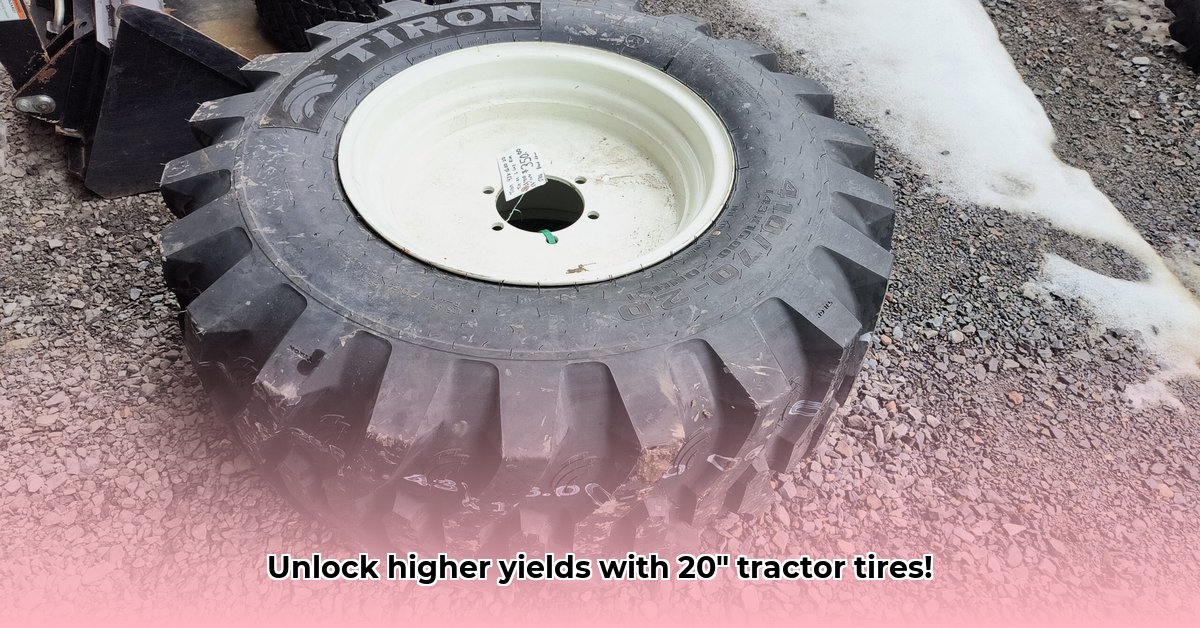
Understanding Your 20-Inch Tractor Tire Options
Choosing the right 20-inch tractor tires significantly impacts farm efficiency, fuel consumption, and soil health. This guide simplifies tire selection, empowering you to make informed decisions for a sustainable and profitable future. For more information on John Deere tractor tires, check out this helpful resource: John Deere Tires.
Decoding Tire Specifications: A Plain English Guide
Navigating tire specifications can be daunting. Let's demystify the key terms:
Ply Rating: This indicates the number of fabric layers in the tire sidewall (higher numbers mean stronger, more durable tires). A higher ply rating translates to greater puncture resistance and a longer lifespan, resulting in cost savings over time.
Radial vs. Bias-Ply: Radial tires (more common) generally offer better fuel efficiency and a smoother ride, minimizing soil compaction. Bias-ply tires provide greater pulling power but can be less fuel-efficient and more damaging to soil structure. The choice depends heavily on your typical workload and soil type.
Tubeless vs. Tube-Type: Tubeless tires are the modern standard, easier to maintain, less prone to punctures, and require less frequent servicing. Tube-type tires necessitate more careful handling and inspection to prevent leaks.
Tread Patterns: Tread patterns significantly influence traction and soil compaction:
- R1: General-purpose pattern, suitable for various soil conditions.
- R1W: Wider tread, minimizing compaction in heavier soils like clay.
- R2: Aggressive lug pattern, providing excellent traction in soft or wet conditions but potentially increasing soil compaction.
The optimal tread pattern directly depends on your soil type: Don't you want to reduce compaction for a healthier harvest?
Here’s a comparison table summarizing these features:
| Feature | Description | Impact on Sustainability |
|---|---|---|
| Ply Rating | Number of fabric layers in the sidewall; higher = stronger | Increased durability, less frequent replacements, reduced waste. |
| Radial vs. Bias | Radial: better fuel efficiency and traction; Bias-ply: more rugged strength | Radial tires reduce fuel consumption and soil damage; bias-ply may be suitable for specific applications. |
| Tubeless vs. Tube | Tubeless: easier maintenance, better puncture resistance; Tube-type: requires tubes | Tubeless tires reduce downtime and waste from leaks. |
| Tread Pattern | R1 (general), R1W (wide), R2 (aggressive) - designs for different soil types | Minimizes compaction, maximizes traction, tailored to specific soil conditions. |
Choosing the Right Tires: A Step-by-Step Guide
Selecting the perfect tire involves a consideration of several key factors. Let's break down the process:
Step 1: Assess Your Soil Type: Identify your predominant soil type (sandy, clay, or loam). This single factor significantly influences tread pattern selection.
Step 2: Estimate Your Load Capacity: Determine the heaviest load your tractor will routinely carry, factoring in implements, harvested crops, and fuel. This dictates the required ply rating.
Step 3: Analyze Your Typical Workload: Heavy-duty work demands robust tires, while lighter tasks allow for choices prioritizing fuel efficiency and minimal soil disturbance.
Step 4: Select the Appropriate Tread Pattern:
- Clay soils: R1W (wide tread) minimizes compaction.
- Sandy soils: R2 (aggressive pattern) enhances grip.
- Loam soils: R1 (general-purpose) is often suitable.
Step 5: Choose the Correct Ply Rating: Select a ply rating that comfortably exceeds your typical load capacity.
Step 6: Decide Between Radial and Bias-Ply: Unless specific needs (extreme pulling power) dictate otherwise, radial tires are generally the more sustainable and efficient option.
Step 7: Opt for Tubeless Tires: Tubeless tires offer greater convenience and reliability.
Tire Maintenance and Best Practices: Maximizing Lifespan and Sustainability
Proper tire maintenance is crucial for extending lifespan and minimizing environmental impact:
- Regular Pressure Checks: Maintain correct inflation pressure. Underinflation increases fuel consumption and wear, while overinflation boosts soil compaction.
- Visual Inspections: Regularly inspect tires for cuts, embedded objects, or uneven wear. Early detection prevents small problems from escalating.
- Tire Rotation: Rotate tires periodically for even wear.
- Proper Storage: Store tires correctly when not in use, preventing damage.
Responsible Tire Disposal: Environmental Stewardship
Even durable tires eventually reach their end-of-life. Research and utilize local tire recycling programs to ensure responsible disposal. This contributes to minimizing environmental impact.
"Choosing the right tires is a small act with a big impact on farm sustainability," notes Dr. Emily Carter, Agricultural Engineer at Cornell University. "Long-term cost savings from fuel efficiency and reduced soil compaction far outweigh the initial investment in higher-quality tires."
By following these guidelines, farmers can significantly boost farm efficiency, promoting both profitability and environmental sustainability. Remember, sustainable farming is a continuous journey, and responsible tire management plays a crucial role.